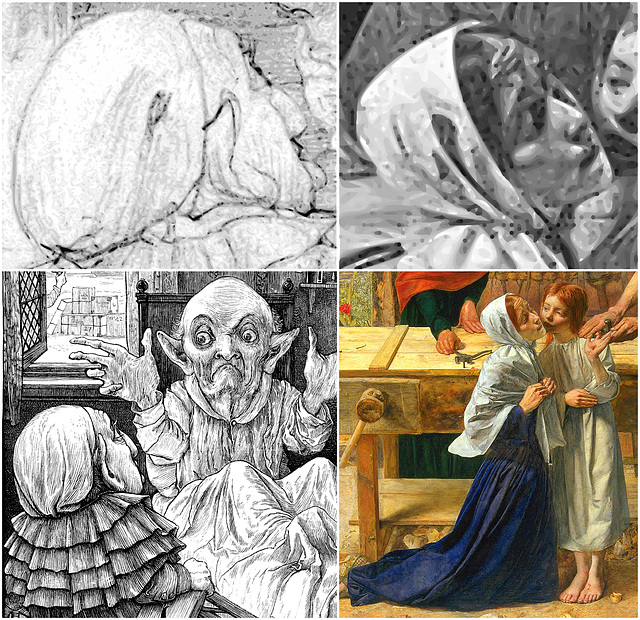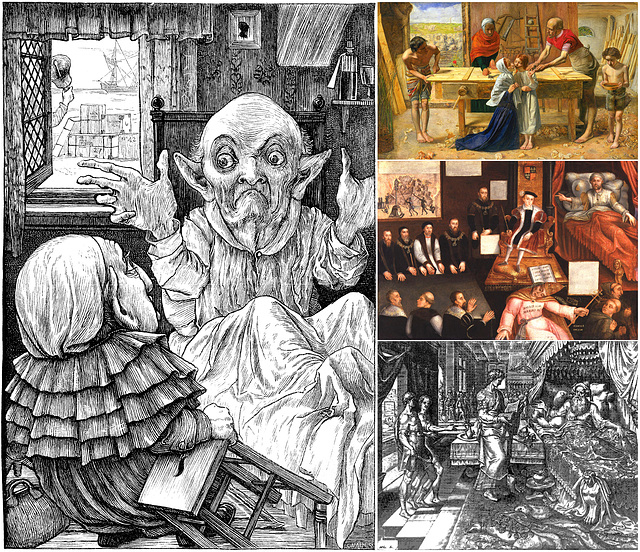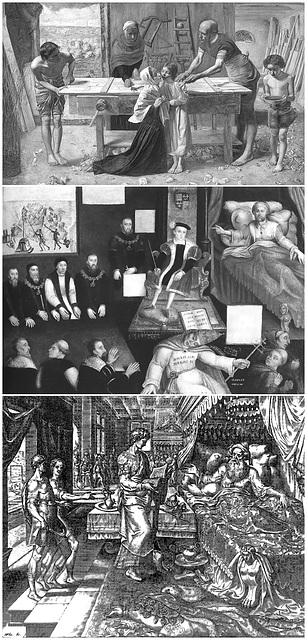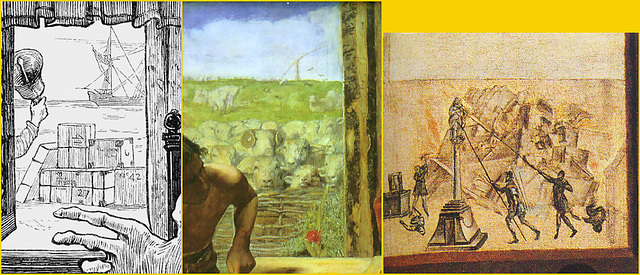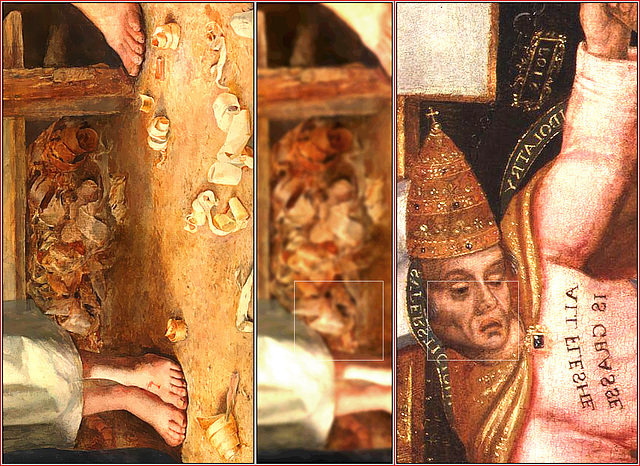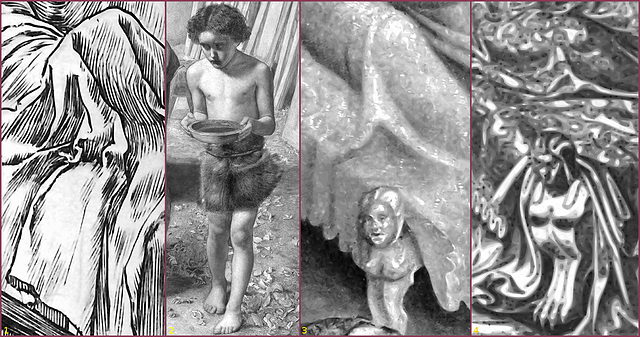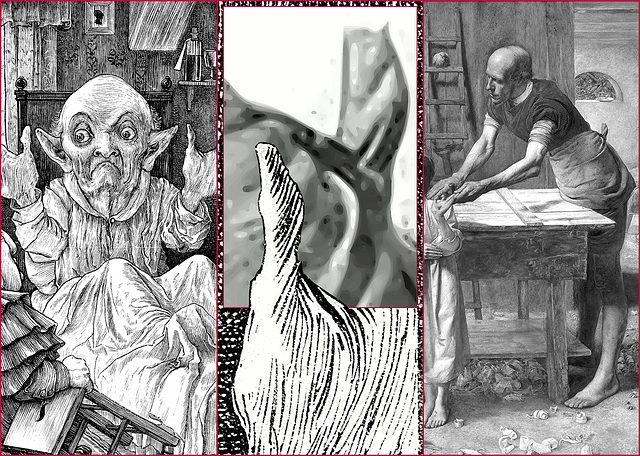
J. E. Millais
Folder: The Hunting of the Snark
There are many comments on Millais' Christ in the House of His Parents in the internet. But most of them are similar. How boring. Seemingly nobody dares to take a new look at the painting.
academia.edu "research interest": www.academia.edu/Documents/in/Christ_in_the_house_of_His_parents
academia.edu "research interest": www.academia.edu/Documents/in/Christ_in_the_house_of_His_parents
27 Dec 2014
5 comments
Mary's and the Baker's Kerchiefs
[left]: Redrawn segment from one of Henry Holiday's pencil drafts for the depiction of the Baker's visit to his uncle (1876) in Lewis Carroll's The Hunting of the Snark . Below the draft you see a segment of the final – and less daring – illustration.
[right]: John Everett Millais : Redrawn Segment from Christ in the House of His Parents (1850) depicting Mary (and a part of Christ's face in the upper right corner). Below that segment you see a larger segment from Millais' painting.
This example shows how Holiday worked on the construction of his conundrums in his illustrations to Lewis Carroll's The Hunting of the Snark . Even though Holiday copied a face from a face, he reinterprated shapes of face elements from the source face in order to represent different face elements with a resembling shape in the target face. The baker's ear is based on a shape in the depiction of Marie's face which is no ear. The same partially applies to the Baker's nose and the baker's eye.
Such kind of pictorial obfuscation should not be a surprise as The Hunting of the Snark is a poem in which readers had been searching textual allusions since 1876. (Too obvuous allusions are too boring.) The focus on textual analysis of the Snark seems to lead us to underestimate Holiday's paralleling Carroll's wordplay with is own means as an graphical artist.
11 Apr 2012
1 favorite
3 comments
Holiday - Millais - Anonymous - Galle
See also: www.academia.edu/9856486/Henry_Holiday_-_and_Millais_Christ_in_the_House_of_His_Parents_
.
The discovery here is the allusion by Henry Holiday to the painting by J.E. Millais. Finding Millais' allusions to an anonymous painter and to Galle's print is a "bycatch" of my Snark hunt. The relation between the anonymous painting and Galle's print already has been explained by Margaret Aston in 1994. That relation brobably has been discovered even earlier by Millais.
.
[left]: Henry Holiday: Depiction (1876) of the Baker's visit to his uncle in Lewis Carroll's " The Hunting of the Snark " (engraved by Joseph Swain). Outside of the window are some of the Baker's 42 boxes.
[right top]: John Everett Millais : Christ in the House of His Parents aka The Carpenter's Shop (1850).
Location: Tate Britain (N03584) , London.
Literature:
* Deborah Mary Kerr (1986): John Everett Millais's Christ in the house of his parents ( circle.ubc.ca/handle/2429/26546 )
* p.34 in (01) Éva Péteri (2003): Victorian Approaches to Religion as Reflected in the Art of the Pre-Raphaelites, Budapest 2003, ISBN 978-9630580380 (shortlink: www.snrk.de/EvaPeteri.htm )
* Albert Boime (2008): Art in an Age of Civil Struggle, 1848-1871
p. 225-364: The Pre-Raphaelites and the 1848 Revolution ( en.wikipedia.org/wiki/Special:BookSources/0226063283 )
[right middle]: Anonymous : Edward VI and the Pope , An Allegory of Reformation, mirrored view (16th century, NPG 4165 ). Iconoclasm depicted in the window. Under the "window" 3rd from left is Thomas Cranmer who wrote the 42 Articles in 1552.
Edward VI and the Pope (NPG 4165) was, until 1874, the property of Thomas Green, Esq., of Ipswich and Upper Wimpole Street , a collection 'Formed by himself and his Family during the last Century and early Part of the present Century' (Roy C. Strong: Tudor and Jacobean Portraits , 1969, p.345). Thus, when Millais' Christ in the House of His Parents ('The Carpenter's Shop') was painted in 1849-1850, the 16th century painting was part of a private collection. It was sold by Christie's 20 March 1874 (lot 9) to a buyer unknown to me, that is, when Holiday started with his illustrations to The Hunting of the Snark .
Location: National Portrait Gallery, London
[right bottom]: Philip Galle after Maarten van Heemskerck , Redrawn print Ahasuerus consulting the records (1564). The resemblance to the image above (right middle) was shown by Dr. Margaret Aston in 1994 in The King's Bedpost: Reformation and Iconography in a Tudor Group Portrait (p. 68). She also compared the bedpost to Heemskerck's Esther Crowned by Ahasuerus .
Location: Rijksmuseum, Amsterdam
25 Feb 2012
1 favorite
4 comments
Holiday - Millais - Anonymous - Galle
See also: www.academia.edu/9856486/Henry_Holiday_-_and_Millais_Christ_in_the_House_of_His_Parents_
.
The discovery here is the allusion by Henry Holiday to the painting by J.E. Millais. Finding Millais' allusions to an anonymous painter and to Galle's print is a "bycatch" of my Snark hunt. The relation between the anonymous painting and Galle's print already has been explained by Margaret Aston in 1994. That relation brobably has been discovered even earlier by Millais.
.
[left]: Henry Holiday: Depiction (1876) of the Baker 's visit to his uncle in Lewis Carroll's " The Hunting of the Snark " (engraved by Joseph Swain). Outside of the window are some of the Baker's 42 boxes.
[right top]: John Everett Millais : Christ in the House of His Parents aka The Carpenter's Shop (1850).
Location: Tate Britain (N03584) , London.
Literature:
* Deborah Mary Kerr (1986): John Everett Millais's Christ in the house of his parents ( circle.ubc.ca/handle/2429/26546 )
p.34 in (01) Éva Péteri (2003): Victorian Approaches to Religion as Reflected in the Art of the Pre-Raphaelites, Budapest 2003, ISBN 978-9630580380 (shortlink: www.snrk.de/EvaPeteri.htm )
* Albert Boime (2008): Art in an Age of Civil Struggle, 1848-1871
p. 225-364: The Pre-Raphaelites and the 1848 Revolution ( en.wikipedia.org/wiki/Special:BookSources/0226063283 )
[right middle]: Anonymous : Edward VI and the Pope , An Allegory of Reformation, mirrored view (16th century, NPG 4165 ). Iconoclasm depicted in the window. Under the "window" 3rd from left is Thomas Cranmer who wrote the 42 Articles in 1552.
Edward VI and the Pope (NPG 4165) was, until 1874, the property of Thomas Green, Esq., of Ipswich and Upper Wimpole Street , a collection 'Formed by himself and his Family during the last Century and early Part of the present Century' (Roy C. Strong: Tudor and Jacobean Portraits , 1969, p.345). Thus, when Millais' Christ in the House of His Parents ('The Carpenter's Shop') was painted in 1849-1850, the 16th century painting was part of a private collection. It was sold by Christie's 20 March 1874 (lot 9) to a buyer unknown to me, that is, when Holiday started with his illustrations to The Hunting of the Snark .
Location: National Portrait Gallery, London
[right bottom]: Philip Galle after Maarten van Heemskerck , Redrawn print Ahasuerus consulting the records (1564). The resemblance to the image above (right middle) was shown by Dr. Margaret Aston in 1994 in The King's Bedpost: Reformation and Iconography in a Tudor Group Portrait (p. 68). She also compared the bedpost to Heemskerck's Esther Crowned by Ahasuerus .
Location: Rijksmuseum, Amsterdam
02 Jun 2013
3 comments
Millais, Anonymous, Galle
[top]: John Everett Millais : Christ in the House of His Parents aka The Carpenter's Shop (1850).
Location: Tate Britain (N03584) , London.
Literature:
* Deborah Mary Kerr (1986): John Everett Millais's Christ in the house of his parents ( circle.ubc.ca/handle/2429/26546 )
p.34 in (01) Éva Péteri (2003): Victorian Approaches to Religion as Reflected in the Art of the Pre-Raphaelites, Budapest 2003, ISBN 978-9630580380 (shortlink: www.snrk.de/EvaPeteri.htm )
* Albert Boime (2008): Art in an Age of Civil Struggle, 1848-1871
p. 225-364: The Pre-Raphaelites and the 1848 Revolution ( en.wikipedia.org/wiki/Special:BookSources/0226063283 )
[center]: Anonymous : Edward VI and the Pope , An Allegory of Reformation, mirrored view (16th century, NPG 4165 ). Iconoclasm depicted in the window. Under the "window" 3rd from left is Thomas Cranmer who wrote the 42 Articles in 1552.
Edward VI and the Pope (NPG 4165) was, until 1874, the property of Thomas Green, Esq., of Ipswich and Upper Wimpole Street , a collection 'Formed by himself and his Family during the last Century and early Part of the present Century' (Roy C. Strong: Tudor and Jacobean Portraits , 1969, p.345). Thus, when Millais' Christ in the House of His Parents ('The Carpenter's Shop') was painted in 1849-1850, the 16th century painting was part of a private collection. It was sold by Christie's 20 March 1874 (lot 9) to a buyer unknown to me, that is, when Holiday started with his illustrations to The Hunting of the Snark .
Location: National Portrait Gallery, London
[bottom]: Philip Galle after Maarten van Heemskerck , Redrawn print Ahasuerus consulting the records (1564). The resemblance to the image above (middle) was shown by Dr. Margaret Aston in 1994 in The King's Bedpost: Reformation and Iconography in a Tudor Group Portrait (p. 68). She also compared the bedpost to Heemskerck's Esther Crowned by Ahasuerus .
Location: Rijksmuseum, Amsterdam
Detail:
The Carpenter and Ahasuerus:
Before I found Millais' allusions as a kind of bycatch of my Snark hunt,
I started with Henry Holiday's allusions to Millais:
An "allusion chain":
Album:
J. E. Millais
05 Jun 2010
1 comment
42 Boxes, Sheep, Iconoclasm
[left]: Segment from Henry Holiday's depiction of the Baker's visit to his uncle (1876) in Lewis Carroll's The Hunting of the Snark . Outside of the window are some of the Baker's 42 boxes.
[center]: Segment from John Everett Millais : Christ in the House of His Parents (1850).
[right]: segment from Edward VI and the Pope , An Allegory of Reformation , mirrored view (Anonymous, 16th century); depiction of iconoclasm. In The King's Bedpost: Reformation and Iconography in a Tudor Group Portrait (1994, p. 72), the late Margaret Aston compared the iconoclastic scene to prints depicting the destruction of the Tower of Babel (Philip Galle after Maarten van Heemskerck, 1567). From Margaret Aston's book I learned that the section showing the iconoclasm scene is an inset, not a window. Actually, I think, it is an inset which was meant to be perceived as a window as well.
·
Holiday quoted pictorial elements from both paintings [center, right]. I assume that he must have noticed, that Millais quoted from the 16th century painting.
17 Sep 2011
1 favorite
4 comments
Wood Shavings turned Pope
From Pope to Wood Shavings
[left]: Rotated segment from John Everett Millais : Christ in the House of His Parents (1850).
[center]: As above. Blurred.
[right]: Rotated segment from anonymous: Edward VI and the Pope, a Tudor anti-papal allegory of reformation, mirrored view (16th century).
07 Aug 2011
1 favorite
1 comment
Holiday - Millais- Anonymous - Galle, detail
#1 - (allusion to the bedpost #3): 1876, Henry Holiday: Segment of an illustration to Lewis Carroll's The Hunting of the Snark (vectorized after a scan from an 1911 edition of the Snark )
#2 - (allusion to the bedpost #3 and to Philip Galle's print #4): 1850, the young John the Baptist in John Everett Millais : Christ in the House of His Parents (aka The Carpenter's Shop ). The left leg of the boy looks a bit deformed. This is no mistake. Probably Millais referred to #3 and to #4.
#3 - (Henry VIII's bedpost): 16th century, anonymous: Redrawn segment of Edward VI and the Pope, An Allegory of Reformation , (mirror view).
#4 - (bedpost #3 alludes to bedpost #4): 1564, Redrawn segment of a print Ahasuerus consulting the records by Philip Galle after Maarten van Heemskerck. The resemblance of #4 to the image #3 (the bedpost) was shown by the late Dr. Margaret Aston in 1994 in The King's Bedpost: Reformation and Iconography in a Tudor Group Portrait (p. 68). She also compared the bedpost to Heemskerck's Esther Crowned by Ahasuerus .
02 Nov 2014
2 favorites
3 comments
Holiday - Millais - Anonymous - Galle; detail
#1, left - (allusion to the bedpost #3): 1876, Henry Holiday (engraver: Joseph Swain): The illustration detail on the very left side is a vectorized scan from Holiday's illustration to an 1910 edition of Lewis Carroll's The Hunting of the Snark .
#1, right: Additionally you see a segment from Holiday's preperatory draft.
#2 - (allusion to the bedpost #3 and to Philip Galle's print #4): 1850, the young John the Baptist in John Everett Millais : Christ in the House of His Parents (aka The Carpenter's Shop ). The left leg of the boy looks a bit deformed. This is no mistake. Probably Millais referred to #3 and to #4.
#3 - (Henry VIII's bedpost): 16th century, anonymous: Redrawn segment of Edward VI and the Pope, An Allegory of Reformation , (mirror view).
#4 - (bedpost #3 alludes to bedpost #4): 1564, Redrawn segment of a print Ahasuerus consulting the records by Philip Galle after Maarten van Heemskerck. The resemblance of #4 to the image #3 (the bedpost) was shown by the late Dr. Margaret Aston in 1994 in The King's Bedpost: Reformation and Iconography in a Tudor Group Portrait (p. 68). She also compared the bedpost to Heemskerck's Esther Crowned by Ahasuerus .
28 Feb 2012
1 comment
Thumb & Lappet
[left]: Henry Holiday : Segment from a depictionof the Baker's visit to his uncle (1876) in Lewis Carroll's The Hunting of the Snark (engraved by Joseph Swain).
[center]: Doesn't this thumb look more like a piece of cloth rather than like a thumb?
[right]: John Everett Millais : Redrawn Segment from Christ in the House of His Parents aka The Carpenter's Shop (1850), presently on display at Tate Britain (N03584) .
Jump to top
RSS feed- Latest items - Subscribe to the latest items added to this album
- ipernity © 2007-2025
- Help & Contact
|
Club news
|
About ipernity
|
History |
ipernity Club & Prices |
Guide of good conduct
Donate | Group guidelines | Privacy policy | Terms of use | Statutes | In memoria -
Facebook
Twitter

